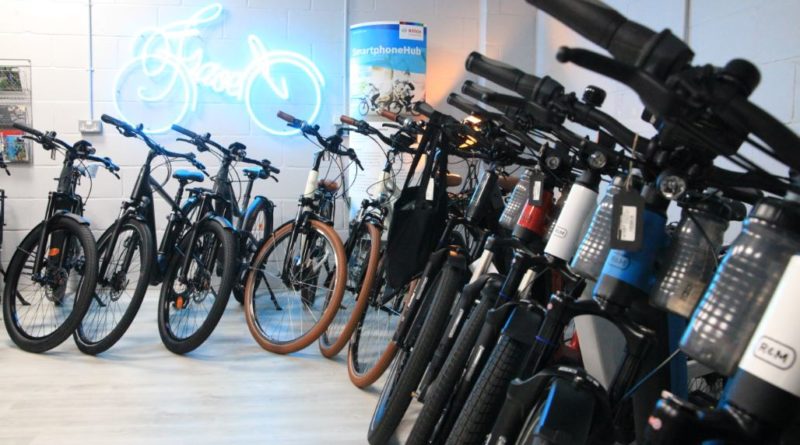Electric bikes continue to prop up bike market, shows WFSGI paper
A new report published today by the World Federation of Sporting Goods Industry (WFSGI) and McKinsey & Company this week has gone into great detail on the trajectory of the sporting goods business, its manufacturing, the intent of its consumers and will of investors to continue pilling cash into brands. It has also once again demonstrated how electric bikes are propping up a flailing bike market.
The third report of its kind, a key takeaway from the plethora of CEO interviews and consumer study work used to compile the paper is that those who spend big on brand building and messaging will be those at the forefront of consumer’s minds as spend rebounds. Over 50% of the surveyed sporting goods players said that they were to increase spending on branding activity to maintain relevance through thick and thin.
Currently the consumer sentiment picture is worse than it has been for some time, which is in small part to blame for one of the bike industry’s main headaches at the present time; a broad picture of overstock and subsequent need to discount stock in order to keep cash flowing through businesses.
Segment breakdowns – Electric bikes lead charge
Specifically in the US cycling market, the NPD Group and Retail Tracking Service documents that a decline in the number of units sold did not offset a high average sales price and as such the market remained ahead of its pre-pandemic valuation ($4.5Bn), though 9.7% did come off the overall tally for 2021 ($6.6Bn) with the 2022 figures registering $5.9 Bn. In volume terms the US cycling market was down 16.9% in 2022 versus the year prior.
Somewhat explaining the volume vs value disparity, the report writes: “The best-performing sub-categories were electric bikes, in which revenues rose 16 percent compared with 2021, amid 400 percent growth since before the pandemic. We expect strong performance in electric bikes to continue, in part because growth is coming from a long-awaited structural shift.”
Again looking at the NPD/Retail Tracking Service data we can see that it was by far the greatest growth area for the cycling market at 16% ahead from 2021 to 2022 and drastically ahead of 2019’s sub $200 million market valuation at closer to $700 million nowadays.
The only other two segments to post growth were road cycling and bike repairs and servicing, both up just 1% year on year, the latter having consistently grown for four years.
Other markets measured include Mountain (down 13%), Children’s (down 24%), Transit and Fitness (13% down), helmets (down 15%), components (down 5%), tyres and tubes (down 10%) and leisure and lifestyle – hit the hardest – at 34% down from 2021 to 2022.
The largest recorded market is the active apparel space, which in 2022 dipped 3.9% to $24.9Bn, but remained ahead of 2019’s $20.5Bn tally.
As for footwear the story repeats with the US valuation topping $20.1Bn, up from $17.8Bn in 2019, but behind 2021’s peak at $21.4Bn.
What’s the consumer thinking?
Consumer intent to purchase sporting goods was found to be 40% worse year-to-year and indeed this is already reflected in the assessment of US sporting goods industry sales, which were said to have declined between 4 and 8% in Q1 to Q3, 2022, versus 2021 across the main tracked categories.
The main reasons attributed by the study and its interview panel were the impacts of inflation and slowed economic growth. This trend was particularly pronounced in Spain and the UK, worsening sharply between December of 2021 into the summer of 2022.
“Furthermore, consumers are likely to reduce their sporting goods spending over the coming period. More than 50 percent of consumers say they will buy fewer items, while about 20 percent say they will trade down to less expensive brands,” writes the report.
The whipsaw effect of extreme demand during the pandemic has put the demand for privately purchased sporting goods in the doldrums, a situation described as “unavoidable” in the conclusion of McKinsey & Company’s Consumer Pulse Survey.
Inflationary pressures are raising prices during a time of lower demand, which is not helping reignite the consumer’s will to spend, but in the near term the challenge for brands is to motor through current over-subscribed stock holdings.
In the clothing and footwear arena we are given a snapshot of expected demand by generation, with younger generations apparently likely to cut their spend least, especially on apparel. The reverse is true for Baby Boomers.
Overall it is sports equipment purchases that look most likely to suffer in the next three months with European consumers, while apparel and footwear will fair marginally better, though still with demand substantially down. Low income earners will, predictably, cut back the value of their spend far more than high income households with the former seem to be ready to cut back 50% on footwear and sports equipment.
“I believe it will take some time for demand and supply to right itself, especially as I suspect the economic conditions may well continue to worsen as we go into 2023, with impacts on consumer confidence,” Colin Browne, Interim President and Chief Executive Officer, Under Armour, was quoted as saying.



